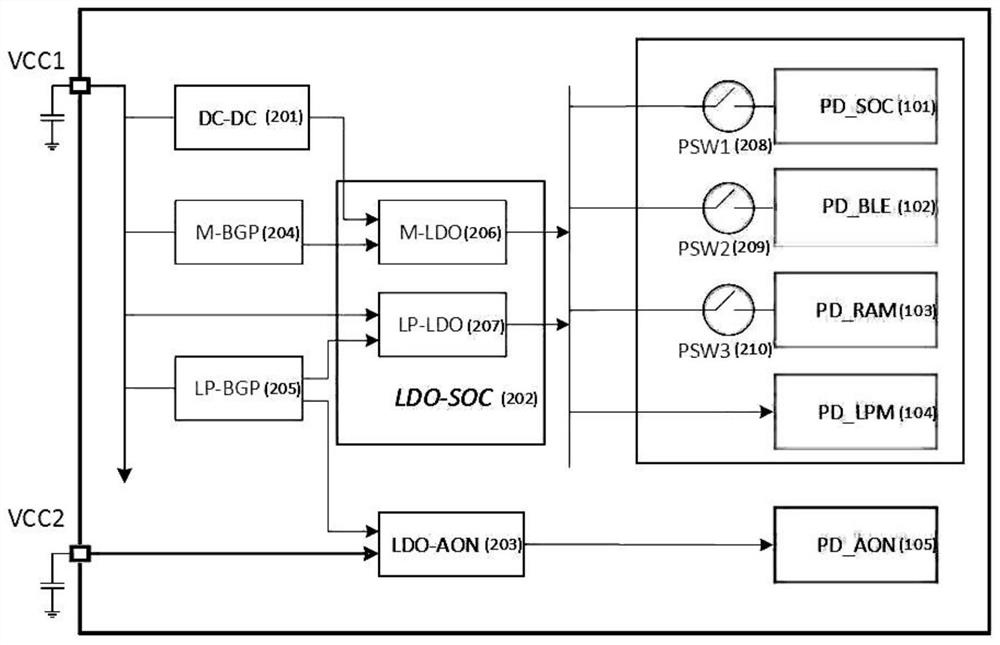Low-power system and method of Internet of Things chip
An Internet of Things chip and low power consumption technology, which is applied in power management, energy consumption reduction, machine-to-machine/machine-type communication services, etc., can solve the problem of low power consumption of chips, so as to promote wide application and reduce overall Effects of power consumption and extended battery life
- Summary
- Abstract
- Description
- Claims
- Application Information
AI Technical Summary
Problems solved by technology
Method used
Image
Examples
Embodiment 1
[0030] This embodiment discloses a low power consumption architecture of an IoT chip, see figure 1 As shown, the IoT chip designed with this architecture includes five power supplies including PD_SOC power domain (101), PD_BLE power domain (102), PD_RAM power domain (103), PD_LPM power domain (104) and PD_AON power domain (105). domain composition. The description of the five power domains is as follows:
[0031] PD_SOC power domain (101): the components of the system on chip including CPU, memory, bus, DMA and peripherals, which are the parts that realize the main functions of the system on chip;
[0032] PD_BLE power domain (102): Bluetooth low energy components including BLE baseband, modem, RF and clock generator, which is a part to realize Bluetooth low energy communication function;
[0033] PD_RAM power domain (103): includes a group of components including SRAM with retention and powerdown modes, which can realize the combination of various low-power modes such a...
Embodiment 2
[0037] This embodiment discloses a low power consumption architecture of an Internet of Things chip. According to the above power domain division, different power domains have their own dedicated power supply sources. See figure 2 and image 3 As shown, the components of the power supply network include two external power supply pins VCC1 and VCC2, DC-DC (201), LDO-SOC (202), LDO-AON (203), MBGP (204), LPBGP (205), PSW1 (208), PSW2 (209) and PSW3 (210).
[0038] Among them, the voltages of the two external power supply pins VCC1 and VCC2 are VCC1: 3V and VCC2: 1.2V;
[0039] Wherein, the DC-DC (201) steps down the voltage of VCC1 from 3V to 1.5V, and provides it to the MLDO (206) in the LDO-SOC (202);
[0040]Among them, LDO-SOC (202) is a dual power supply component composed of two LDOs, MLDO (206) is a power supply for normal operation, and MBGP (204) provides a reference voltage. LPLDO (207) is the power supply source used for the low power consumption state, and the re...
Embodiment 3
[0046] This embodiment discloses a low power consumption architecture of an Internet of Things chip. There are 7 power consumption modes in total. The working conditions of each power supply in different power consumption modes are shown in the following table:
[0047]
[0048] The low-power architecture of an IoT chip disclosed in this embodiment has 7 power consumption modes in total, and the working conditions of each power domain in different power consumption modes are shown in the following table:
[0049]
[0050] Among the 7 power consumptions, we will focus on the Hibernate mode. Based on the design of dual power supply switching, the Hibernate mode is a unique mode for implementing a low-power architecture of an IoT chip that takes into account both response speed and power consumption. The Hibernate mode is divided into two modes: Hibernate_1 and Hibernate_2.
[0051] The working principle of Hibernate_1 schema is described below. All power domains are power...
PUM
 Login to View More
Login to View More Abstract
Description
Claims
Application Information
 Login to View More
Login to View More - R&D
- Intellectual Property
- Life Sciences
- Materials
- Tech Scout
- Unparalleled Data Quality
- Higher Quality Content
- 60% Fewer Hallucinations
Browse by: Latest US Patents, China's latest patents, Technical Efficacy Thesaurus, Application Domain, Technology Topic, Popular Technical Reports.
© 2025 PatSnap. All rights reserved.Legal|Privacy policy|Modern Slavery Act Transparency Statement|Sitemap|About US| Contact US: help@patsnap.com



